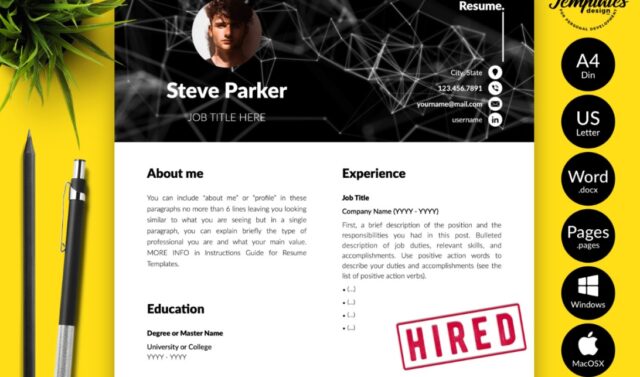In the competitive landscape of today’s job market, your resume serves as the first impression for potential employers. The way your resume is typed, formatted, and presented can be the difference between landing an interview or being overlooked. Professional resume typing is no longer just about listing your qualifications—it’s about strategically presenting your professional narrative in a visually appealing, easily scannable, and ATS-compatible format.
Why Resume Typing Skills Matter in Today’s Job Market
According to recent employment statistics, hiring managers spend an average of just 7.4 seconds scanning a resume during the initial review. This brief window makes the technical aspects of resume typing—such as formatting, spacing, font selection, and overall document structure—critically important to catching and maintaining the recruiter’s attention.
The Evolution of Resume Typing: From Typewriters to Digital Optimization
Resume typing has evolved dramatically over the decades. What began as documents created on typewriters with limited formatting options has transformed into strategic digital documents optimized for both human readers and applicant tracking systems.
The Digital Revolution in Resume Creation
Today’s resume typing incorporates:
- Strategic keyword optimization for ATS systems
- Personal branding elements
- Custom typography and formatting
- Digital delivery methods
- Interactive elements like hyperlinks to portfolios or LinkedIn profiles
These advancements make modern resume typing a multifaceted skill requiring technical knowledge, design sensibility, and strategic thinking.
Essential Resume Typing Formats: Choosing the Right Structure
Understanding the different resume formats is crucial before you begin copy typing. Each format serves specific purposes depending on your career circumstances.
Chronological Resume Format
The chronological format places your work history front and center, listing positions in reverse chronological order (most recent first). This traditional resume typing style works best for:
- Candidates with a stable work history
- Job seekers staying within the same industry
- Professionals demonstrating clear career progression
Functional Resume Format
The functional resume format emphasizes skills and accomplishments rather than employment timeline. When typing this format, you’ll group achievements by skill category. This approach works well for:
- Career changers
- Candidates with employment gaps
- Professionals with diverse experience across industries
Combination/Hybrid Format
This format combines elements of both chronological and functional formats. When typing a combination resume, you’ll include both a robust skills section and a detailed work history. This comprehensive approach benefits:
- Experienced professionals
- Candidates applying for specialized positions
- Job seekers with both impressive skills and steady work history
Technical Aspects of Professional Resume Typing
The technical execution of your resume dramatically impacts its effectiveness. Here are the essential technical considerations for professional resume typing:
Font Selection and Typography
When typing a resume, font choice significantly impacts readability and professionalism:
- Stick to professional fonts like Calibri, Arial, Garamond, or Georgia
- Maintain consistent font size (10-12pt for body text, 14-16pt for headings)
- Use bold and italics sparingly for emphasis
- Avoid decorative or novelty fonts that may distract from content
Spacing and Layout Considerations
Proper spacing enhances readability and visual appeal:
- Maintain consistent line spacing (1.0-1.15 for dense resumes, 1.15-1.5 for less content)
- Use sufficient white space around sections
- Create clear visual separation between resume segments
- Ensure margins are between 0.5-1 inch on all sides
File Format Selection
The file format you choose for your typed resume matters:
- PDF format preserves formatting across devices and platforms
- Word documents (.docx) allow for ATS compatibility but may shift formatting
- Plain text versions (.txt) may be required for certain application systems
ATS Optimization Techniques for Resume Typing
When typing your resume in today’s job market, optimizing for Applicant Tracking Systems (ATS) is non-negotiable. These software systems scan resumes before human eyes ever see them.
Keyword Integration Strategies
Strategic keyword placement significantly improves your resume’s ATS performance:
- Analyze job descriptions for industry-specific terminology
- Incorporate relevant keywords naturally throughout your document
- Include both spelled-out terms and acronyms (e.g., “Search Engine Optimization (SEO)”)
- Place critical keywords in section headings and opening statements
ATS-Friendly Formatting Tips
When typing your resume, certain formatting choices improve ATS compatibility:
- Avoid text boxes, tables, and complex graphical elements
- Use standard section headings (e.g., “Work Experience” rather than creative alternatives)
- Minimize header and footer usage for important information
- Avoid image-based content that ATS systems cannot read
Industry-Specific Resume Typing Considerations
Different industries have distinct expectations for resume formatting and content. Understanding these nuances improves your chances of success.
Creative Fields Resume Typing
When typing resumes for creative industries:
- More design freedom is typically acceptable
- Portfolio links become essential components
- Visual elements can demonstrate design capabilities
- Balance creativity with readability
Corporate and Traditional Sectors
For corporate positions, resume typing should prioritize:
- Conservative formatting
- Quantifiable achievements
- Industry-specific terminology
- Traditional chronological structure
Technical and IT Resume Typing
Technical resumes benefit from:
- Skills matrices showing proficiency levels
- Technical certification highlights
- Project-based experience descriptions
- Specific technical keyword integration
Common Resume Typing Mistakes to Avoid
Even experienced professionals make resume typing errors. Here are the most common mistakes to avoid:
Formatting Inconsistencies
Inconsistent formatting undermines professionalism:
- Mixing font types or sizes
- Inconsistent bullet style or spacing
- Varying date formats
- Misaligned text or margins
Content Errors
Content problems damage your credibility:
- Typos and grammatical errors
- Passive voice overuse
- Vague achievement descriptions
- Irrelevant information inclusion
Technical Failures
Technical issues can disqualify your application:
- Incompatible file formats
- Excessive file size
- Broken links or interactive elements
- Formatting that breaks when opened on different devices
Professional Tools for Resume Typing Excellence
The right tools elevate your resume typing process and final product. According to research from Resume Lab, professionally formatted resumes are 71% more likely to receive interview callbacks.
Word Processing Software
Modern word processors offer specialized resume typing features:
- Microsoft Word’s resume templates
- Google Docs’ collaborative editing capabilities
- Apple Pages’ design-forward templates
Specialized Resume Building Platforms
Dedicated resume platforms provide structure and guidance:
- Resume.io for guided creation
- Novoresume for modern designs
- Canva for visually striking templates
Grammar and Optimization Tools
These tools enhance the quality of your typed resume:
- Grammarly for error detection
- Jobscan for ATS optimization analysis
- Hemingway Editor for readability improvements
How to Maintain Resume Typing Consistency Across Job Applications
Consistency across applications while tailoring to specific positions presents a challenge. Here’s how to manage this balance:
Creating a Master Resume Document
Develop a comprehensive master document containing:
- All work experiences
- Complete skills inventory
- All educational credentials
- Various achievement descriptions
This serves as your source material for tailored applications.
Tailoring Without Losing Formatting
When customizing for specific positions:
- Maintain consistent formatting templates
- Adjust content without changing structural elements
- Save unique versions with position-specific naming conventions
- Review each customized document for formatting consistency
The Future of Resume Typing: Emerging Trends
The landscape of resume typing continues to evolve with technology and workplace changes:
Digital Portfolio Integration
Modern resumes increasingly incorporate:
- QR codes linking to online portfolios
- Embedded video introductions
- Interactive infographic elements
- Digital skill visualization
AI and Automated Personalization
Emerging technologies are changing resume customization:
- AI-powered content recommendations
- Automated formatting adjustments
- Dynamic keyword optimization
- Real-time ATS compatibility scanning
As highlighted by Harvard Business Review, AI tools are reshaping resume creation and screening processes.
Mastering Resume Typing for Career Success
Professional re -typing typing represents a significant skill in today’s competitive labor market. You can create application documents that effectively show your ability and improve your landing opportunities by masting ATS requirements, understanding ATS requirements, avoiding normal errors and taking advantage of professional equipment.
Remember that your writing starts both as a professional marketing document and reflection of your attention for expansion. To correct the technical aspects of your CV writing, it shows the same caution by taking the time to bring you in your- professional role.
Whether you are entering the job market for the first time, changing your career or moving in the industry, investing in a professional re -starting skills pay dividends in the efficiency and opportunities for career development.










